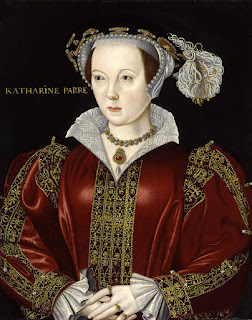The English-language version of the nearly 5 century’s old composition was first brought to the attention of both musical and monarchial spheres in 1978, when the manuscript was discovered tucked inside of a cavity behind the plastered walls of Oxford’s Corpus Christi College. It has since undergone much scrutiny by scholars in regards to the date the music was written and for which English Monarch – King Henry VIII, or his daughter by Katherine of Aragon, Queen Mary Tudor. Researchers in favor of Mary cite the prevalence of like-Marian votive antiphons made popular during the Queen’s reign (a much frequented source of propaganda for the Monarch which conveniently contrasted both Mary’s - the Blessed Virgin Mary, and the exalted Queen Mary on earth – in the minds of loyal subjects; and a musical format of which composers living in Mary's time would often use to their advantage). Researchers in favor of Henry VIII note the unusual presence of an English text for the music – a practice most uncommon for such a composition – likening it to the newly protestant services mandated by the King’s son and future monarch, Edward VI. Supporters of this theory date the music to the late term of Henry VIII, and believe the work’s lyrics to have been translated from their original Latin into English just prior to the ascension of the royal heir.
Such has been the lyrical controversy for the past four decades – that is until very recently, when one eagle-eyed Cambridge scholar noticed a direct match between the text of Gaude Gloriosa Dei Mater and a particular psalm authored by English Queen Catherine Parr sometime in 1544. Parr’s ninth psalm “Agaynst enemies” was part of a larger work penned by the former Monarch during her marriage to King Henry VIII – a book of "Psalms or Prayers" which the Queen had published (as an English translation of a Latin devotional text penned by Catholic Saint John Fisher) in support of her royal husband’s highly contested campaign against the French.
 |
| Henry VIII's sixth (and final) wife, consort Queen of England and Ireland Catherine Parr. |
“Henry wanted the people to rise up and ‘pray’ him into battle, as later that July he was to lead his armies at the Siege of Boulogne…”
But in order to accomplish such a feat, Henry would have to replace the use of traditional Latin litany and prayer – incomprehensible to most outside of the clergy – into a language that could be understood even by the “common man.” For this, it seems Henry would turn to his then-wife – ardent supporter of the King and skilled linguist Catherine Parr. The Queen certainly delivered – Parr’s translation of Fisher’s text is aptly described by Skinner as both “searing and wrathful… very much at odds with the original devotional nature of the Latin.”
He cites an example of Parr’s text:
“[C]ast them down hedlonge, for they are treatours & raybels agaynst me … let the wicked sinners returne in to hell”Further lending support to Skinner’s conclusion of Royal authorship lay in the books’ penultimate and final prayers, entitled “A prayer for the King” and “A prayer for men to say going into battle,” both of which give credence to the notion that Gaude Gloriosa Dei Mater was indeed composed much prior to Mary's ascension to the throne in 1553 - likely during the latter half of King Henry VIII's reign, when England was embroiled in a bitter war with both Scotland and France.
Indeed, it is easy to imagine the gusto that must have been felt by English troops as they rushed into battle, armed with this fully comprehensible, and supremely aggressive anthem freshly ingrained in their minds.
The Gaude Gloriosa Dei Mater is set to premiere in London, both under its correct authorship, and in the English tongue for next month’s Holy Week (from Palm Sunday on the 9th to Holy Saturday on the 15th). The Alamire choir (of which Skinner is director) is slated to perform. Click here for more details.
Listen below to Tallis' Gaude Gloriosa Dei Mater, in it's original Latin form:
Did You Know?
No one really knows with any certainty what Thomas Tallis looked like - the famous engraving of the composer (left) dates from the mid-18th century, and is nothing more than the product of one artists' perception (i.e. imagination). There are no official portraits of the composer that survive.
Learn more:
- article (with images of manuscript) at the Telegraph
- David Skinner's published findings, Aug 2016 at Oxford Academic (*membership/purchase)
-Rose.























